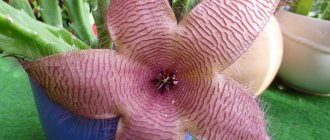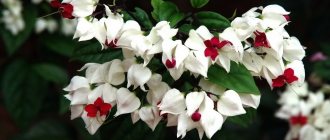Since ancient times, delicate, colorful, daisy-like gerberas have been the personification of joy and lightness, becoming guardians of love and fidelity. So, having settled a bush of bright flowers in your home, expect changes for the better. A nice bonus is that the plant is unpretentious. And even if this is your first experience of growing indoor gerberas, don’t worry, caring for the plant will not take much time and effort. The main thing is to take the trouble to understand the basic needs of your exotic guest and create the most “native” microclimate for her.
Briefly about care
| Type of agricultural operation for caring for gerbera | Description of conditions and actions |
| Watering and air humidity | During the period of intensive growth and flowering, water twice a week (after the top layer of soil has dried) with soft, moderately warm water in autumn and winter, reduce the number of waterings to 1-2 times a month, it is better to water from a watering can with a narrow spout along the edge of the pot so that moisture does not fell on a leaf rosette, the plant needs high humidity up to 70% |
| Lighting organization | Daylight hours are at least 12 hours (in the autumn-winter period additional lighting with phytolamps is required); loves a lot of bright light, but in extreme heat it is better to shade it from aggressive ultraviolet radiation |
| Maintaining a rest period | From mid-November to second half of February |
| Creating temperature conditions | In spring-summer 20-24 ºС in winter 14-16 ºС; during the flowering period, do not allow sudden temperature changes, do not allow the air to cool below 19 ºС |
| Trimming | Only during reproduction |
| Making soil mixture | Well-permeable, slightly acidic loose soil made of leaf soil, peat and sand (2:1:1); you can add a little pine bark |
| Fertilizer application | Once every one to two weeks, when watering, use complex fertilizers for flowering plants:; During intensive growth and summer, gerbera requires nitrogen; flowering bushes should be fed with potassium; flowers growing in a cool room should be additionally fed with phosphorus; to prepare the solution, use a halved concentration of mineral fertilizers |
| Transfer | Every year with the arrival of spring, as soon as young greenery appears |
| Chemical treatment | Insecticides: whitefly, aphids, spider mites, scale insects, mealybugs; fungicides: mold, powdery mildew, late blight, gray rot, chlorosis |
Caring for indoor gerbera
As mentioned above, growing gerberas at home, in the form of a potted crop, is not an easy task, especially since almost all specimens sold in stores are grown in Holland using powerful hormones, which means they are not designed for a long life.
And yet, you want to keep a flower bought or given as a gift. And it is possible. Let's find out how.
Features of cultivation
There are several points that a gardener growing indoor gerberas should pay attention to:
- Lifespan of a gerbera. There is an opinion that domestic gerberas are annual plants and die after flowering. This is not entirely true. If a Dutch gerbera brought from a store is not replanted and cared for in time, the flower will actually die. If you create all the conditions (replace purchased soil, water and feed on time), the gerbera will live for several more years. In the future, the old bush can be rejuvenated.
- Rest period. Gerbera is one of those indoor representatives of the kingdom of Flora for which it is necessary to arrange a cool winter. If this rule is not followed, flowers are unlikely to appear again.
- The delicate leaves and stems of gerberas are often covered with a white coating. This is powdery mildew, a fungal disease that is caused by excess moisture. That is why special attention should be paid to watering and spraying gerberas.
- The plant does not require special pruning or shaping. All care comes down to cleaning up dry leaves and putting the pot in order.
What to do after buying a gerbera
For the first week and a half, do not touch it. Let the gerbera adapt and get used to the new atmosphere and recover from the stress it has suffered. Then you need to wait for the end of flowering or simply pick all the flowers and buds: this process takes a lot of energy from the plant, and flowering, combined with the stress of changing place of residence, can completely destroy the southern beauty. After this, the gerbera can be transplanted.
[!] All old store soil, the so-called shipping soil, should be shaken off or washed off as carefully as possible, trying not to damage the delicate roots.
If the plant does not adapt well, you can place it in a bag, creating a mini-greenhouse. From time to time the bag needs to be removed and the flower ventilated.
Air temperature and lighting
Since this flower comes from southern countries, the temperature for successful growth and flowering must correspond to natural conditions: 18-20°C in summer and 14-16°C in winter. It is quite difficult to create such conditions in an apartment: both in winter and in summer our apartments are much warmer. Therefore, on particularly hot days, you should shade the flower, and in winter, during the heating season, place it in a cool room.
[!] In late spring and summer, you can take the pot of gerbera to the loggia, balcony or garden plot. Fresh air has a beneficial effect on the plant.
Almost all flowers love good lighting, not excluding gerberas, but direct sun on hot days can damage delicate leaves. The best location would be windows facing east or west. If the plant is located on a southern windowsill, it needs to be shaded from direct sunlight, and if on a northern one, it should be additionally illuminated with a phytolamp.
Watering and air humidity
“How to water a gerbera?” - a question often asked on forums for house plant lovers. The answer is quite simple - moderately. Both drying out of the earthen clod and excessive stagnation of moisture are equally harmful to Transvaal chamomile.
In general, in summer, on hot days, you need to water more often, and in autumn and winter, the amount of moisture needs to be reduced. You can determine the need for watering by looking at the substrate - its top layer should dry out by about 3-4 cm. To reduce the likelihood of rot, it is better to remove the water that has accumulated in the pan after watering.
[!] According to experienced flower growers, it is better to underwater a gerbera than to overwater it. And slightly withered leaves of a flower are a sure sign that the plant is thirsty.
[!] Use only settled or filtered water at room temperature. Moisture must not get inside the leaf rosette.
Gerbera is a plant that prefers high air humidity. In the warm season, it can and should be sprayed generously. But as soon as it gets colder, spraying should be significantly reduced or stopped altogether. High humidity combined with low temperatures can cause tender leaves to rot.
Some gardeners believe that drops falling on delicate leaves leave unsightly spots. This is not entirely true. You can spray the leaves, but you need to do it correctly:
- Use only a fine spray bottle.
- If in doubt, spray not the plant itself, but the air around it.
- Water for spraying, as well as for irrigation, should be warm.
- If it is cool and damp outside, there is no need to spray the gerbera.
- In addition, you should not spray gerberas standing in direct sun. Drops dried by rays cause burns on gerbera leaves.
Transplantation, soil, fertilizing
Transplantation, or rather transshipment, is done every year. As soon as spring comes, the gerbera with the old earthen lump is transferred to a new pot, the volume of which should be slightly larger than the previous container. You should not use a bowl that is too large “for growth” - the excess substrate, free from roots, becomes acidic, which provokes root rot, and flowering in such a bowl may not begin.
There are several requirements for the soil for planting home gerberas - looseness, water and air permeability, neutral acidity, low organic content. Can be used:
- universal purchased soil with the addition of vermiculite and crushed charcoal,
- ready-made mixture for roses with the addition of vermiculite and crushed charcoal,
- leaf soil, sand and peat in a ratio of 2:1:1.
You can try pure, without impurities, perlite as a primer. In this case, root rot will not develop, but the plant will have to be constantly fed with fertilizers, since there are no necessary minerals in such soil.
Regardless of the selected soil mixture, a high (1/4 of the total volume) layer of drainage must be poured onto the bottom of the pot in which the gerbera grows. This could be expanded clay, small pebbles, pieces of shells and the like.
[!] When transferring a plant to a new pot, do not damage the roots and do not bury the root collar.
You can fertilize your home gerbera with mineral fertilizers for flowering plants, containing all the microelements the plant needs. The frequency of fertilizing is once every two weeks in spring and summer and no more than once a month in the cold season. Do not feed indoor gerberas with organic matter in the form of liquid manure fertilizers; southern flowers cannot tolerate such feeding.
Gerbera propagation
There are only three ways to propagate this beautiful indoor plant: cuttings, seeds, and dividing the bush.
Cuttings
This method is perhaps the simplest. It is enough to carefully separate a cutting with several leaves and a small root from the mother plant and plant it in a small pot in a peat-sand mixture. To make the cuttings take root better, you can build a mini-greenhouse by covering it with a bag and placing it in a bright, warm place. From time to time, the planted shoot needs to be watered and ventilated by removing the bag. When the cutting gets stronger, you can transplant it into regular soil.
Planting seeds
This is a more labor-intensive method that requires patience from the grower. However, it is always interesting to watch the growth of a seed, and the first flower that blooms compensates for all the efforts. This process can be described step by step as follows:
- We prepare plastic containers in advance (preferably with a lid), fill them with peat soil, moisten them with a spray bottle and sow seeds on the surface.
- Sprinkle dry sand on top and again moisten generously with a spray bottle.
- Cover the box with a lid or, if there is none, with glass, simulating a mini-greenhouse.
- The first shoots should appear in about a week.
- After three or four true leaves appear, we pick out the young gerberas, and then, after another couple of leaves grow, we plant them in permanent places.
As a rule, gerbera grown from seeds blooms in about a year.
Dividing the bush
Propagation by dividing the bush is best used during the annual transplantation of gerberas.
[!] Only an adult, four-year-old bush with several growth points can be divided. Blooming gerberas cannot be divided.
We take the plant out of the pot, shake off the soil and use sharp knives to cut it into the required number of parts so that each part contains a growth point and a certain number of roots. To avoid rot, sprinkle the cuts with crushed coal and plant each part in a separate container with a standard substrate.
Pests and diseases of gerbera
Many insect pests attack gerbera - whitefly, aphids, mealybugs. But the flower is especially attractive to spider mites. Small colonies of insects can be removed using a soap solution. When their numbers grow, only modern insecticides will help. They need to be used twice at intervals of a week.
Gerbera, like all capricious, beautifully flowering plants, gets sick quite often. The slightest mistake in care, and now the leaves have sadly drooped, but there are still no buds. The main advice is to care for your gerbera according to all the rules, do not overwater the flower, feed it and replant it on time.
Gerbera especially often suffers from various rots. Sometimes, with a lack of minerals, chlorosis develops. What exactly the green pet is sick with can be determined by its symptoms.
Gerbera leaves become covered with a white coating and dry out. Most likely, the plant has contracted powdery mildew. This disease can be controlled using systemic fungicides and growth stimulants. In addition, errors in care should be excluded (watering too often, spraying with cold water, lack of lighting).
The color of flowers and leaves fades, the stems become elongated. Probable causes are lack of nutrition and poor lighting.
The edges of the leaf turn yellow and dry out, and then the entire leaf. Such symptoms indicate flooding or overfeeding of the plant.
The interveinal space of the leaf turns yellow, but the veins themselves remain green - this is chlorosis, a disease that occurs from a lack of iron in the soil. It is necessary to feed the gerbera with a special fertilizer - iron chelate.
The lower leaves of the gerbera dry out, the upper ones look healthy and develop normally. It's okay, this way the plant is renewed. To help it a little, old dried leaves can be removed.
***
Of course, gerbera is not easy to grow at home, it is capricious, often gets sick, and flowers from Holland are not at all designed for a long life. But do our flower growers give in to difficulties? Of course not. Therefore, indoor gerberas, no matter what, decorate the window sills of houses and apartments, delighting with their bright beauty and uniqueness.
Description of the plant
Gerbera (lat. Gerbera) is a long-lived herbaceous plant from the Asteraceae/Asteraceae family. At the moment, more than 80 species of gerberas grow in different parts of the world. Beautifully flowering ornamental plants are grown on an industrial scale - for cutting, in garden plots and as potted crops. In its natural habitat, the exotic plant is found in South Africa, India, China and Madagascar.
In nature, gerberas reach impressive sizes. Large baskets of flowers look like garden chamomile, painted in warm, rich shades. If there are double flowers, from a distance they resemble large asters. According to their shape, all gerberas can be divided into four groups:
- Single flowers. Gerberas with a row of non-overlapping petals and a green disk core.
- Duplex. Plants with a double row of overlapping petals and a black, green or dark red heart.
- Crested. Of interest are two rows of overlapping petals with one or more inner rows of shorter petals. The core is scarlet or black.
- Double Crested. Gerberas with continuous overlapping rows of petals, the size of which decreases towards the center, covering it.
The home (indoor) gerbera is intended for growing in an apartment, characterized by its compact volume and height of about 30 cm. Indoor varieties have a lot of differences: different shapes of inflorescences, colors, etc. However, the main characteristics of the bright representatives of the Asteraceae are unchanged. Do you want to know what gerbera flowers look like and recognize them at first sight? So, be sure to understand the following:
| Characteristic | External signs |
| Stem | Low single elastic peduncle |
| Leaves | Delicate green, large, pinnately dissected with notches at the edges, collected in a basal rosette |
| Flowers | Large colorful baskets 5 cm in diameter; petals are double, semi-double or single, painted in all rainbow shades except blue; the core is yellow or dark |
| Root system | The rhizome is solid, formed by numerous cord-like roots |
Especially often in indoor floriculture, mini-bushes with peduncles no higher than 30 cm or a mix are grown - compositions of gerberas of different colors, planted in one pot.
Botanical description and origin
The gerbera flower itself is a complex inflorescence, it is called a basket , the diameter of which ranges from 4 to 30 centimeters. Along the edge of the inflorescence there are very delicate flowers (but we are used to calling them petals), reminiscent of tongues in shape. There are also middle flowers. They are presented in the form of a yellow tube. In a word, everything that we usually call one flower is a whole inflorescence that combines up to a hundred individual flowers.
The leaves of the white beauty also surprise with their grace. The leaf blades are serrated along the edges, as if unusually cut, and emerge directly from the rosette. They reach a length of up to 30 centimeters. Often the foliage is covered with whitish fluff. As for the stems without foliage, they reach a height of up to 60 centimeters. And also downy.
Transvaal daisies are considered very suitable for commercial activities as they have a long flowering period of approximately 4 months. And after cutting, they retain their attractive appearance in a vase for up to three weeks.
Gerberas were first discovered in South Africa and the subtropical regions of Madagascar and India. Japan, China, Mongolia, Australia, as well as in South America. The popularity of these colors was ensured by the Scot Robert Jameson . who at one time sent the unknown plants found to the botanical garden. You can learn about Jameson's gerbera from this article.
REFERENCE! In Europe, gerberas became known only at the beginning of the 20th century. At the moment, about seven dozen varieties of Transvaal daisy are known. For such a result we should be grateful to the fruitful work of breeders.
Popular varieties of indoor gerberas
It is almost impossible to find natural species of tropical plants at home. If your gerbera is growing in a flower pot, it is most likely a hybrid variety, specially bred for indoor growing. By crossing Jameson's gerbera with more resistant varieties, breeders have developed many hybrids that differ in size, shape and color. They can be classified as follows:
| Group | Distinctive features |
| Small-flowered with narrow petals | The diameter of the inflorescence is up to 9-10 cm, the peduncle is 50 cm; a popular representative is the gerbera “Aldebaran” |
| Large-flowered with narrow petals | Inflorescence 9-13 cm, peduncle up to 70 cm common: gerberas with rich yellow flowers “Jupiter”, powdery “Migar” |
| Large-flowered with medium petals | The diameter of the inflorescence is 11-13 cm, the peduncle is up to 70 cm; the best seller is the blood-red “Mars” |
| Large-flowered with wide petals | Inflorescence 10-15 cm, peduncle up to 60 cm, red varieties of gerbera are popular: “Romeo”, “Delios” pink “Vera”, yellow-orange “Saturn” |
| Semi-double and double with narrow petals | The diameter of the inflorescence is up to 11 cm, the height of the peduncle is up to 50 cm, especially in demand in indoor floriculture: gerberas with pink flowers “Viola”, yellow “Kalinka”, juicy red “Sonya” |
| Semi-double and double with wide petals | Flower 11-14 cm, peduncle height up to 70 cm The most popular variety is “Spark” |
Competent care
In order for indoor gerbera to develop normally at home, immediately after purchase, provide it with proper care and create a suitable microclimate. Proper watering and humidity in the room where Transvaal chamomile grows plays a very important role. If there is an excess of liquid, the plant will begin to rot; if there is too little, it will begin to dry out. Too dry air is destructive, but spraying gerbera can lead to many troubles. What is the best way to water a gerbera:
- along the edge of the pot so that drops of water do not fall on the above-ground part of the plant;
- through a tray of water, immersing the pot in it for 20-30 minutes.
Attention! Watering with too cold water can cause plant diseases, and waterlogging the soil can lead to the development of nematodes (small worms that are very difficult to remove).
During the heating season or in the summer, when the air in the apartment dries out, tropical inhabitants have a hard time. The method used for other plants is not suitable here - spraying with a spray bottle will lead to rotting of the leaf rosette and the death of the entire flower. And yet, in order for the plants not to wither, they need to be provided with sufficient moisture. This will help you:
- household humidifier;
- wet expanded clay (place it in a tray and place a flower pot on it);
- spraying water in the room (at a safe distance from the plant);
- indoor decorative fountain;
- aquarium.
To prevent your gerbera from needing treatment, protect it from disease and pests with prevention. Spray with pesticides from time to time, do not forget to disinfect the substrate. Also note the following:
- Stuffiness and excessive air humidity can lead to the development of fungi.
- If you get carried away with watering, the plant will rot.
- If you treat the leaves with alcohol-containing products, you will cause burns.
- Place the indoor relative of the Jemson gerbera in a sunny window - the leaves will turn pale.
- If you do not provide sufficient lighting, the plant will begin to stretch and lose its decorative properties.
Conditions for landing
Many gardeners, especially inexperienced ones, are put off by such high demands of gerberas. No wonder, because their cultivation in open ground is indeed accompanied by certain difficulties. To grow this flower in our latitude in your garden plot, they must be dug up annually before the cold weather. In this they are similar to dahlias.
The soil
So, what soil composition is suitable for such a capricious lady? This culture prefers loose soil , through which air can pass well and in which moisture will not stagnate. You can buy ready-made soil mixture at almost any flower shop. You can also purchase land for planting roses. Or you can prepare the substrate yourself at home. To do this you will need:
- Peat.
- Sand (fine).
- Leaf turf.
Mix all this in the same ratio. Perhaps the second option for the components of the soil mixture will suit you. To do this, you need to create a drainage layer and then cover it in rows:
- turf soil (2 parts);
- leaf soil (1 part);
- humus (1 part);
- sand (also fine and also 1 part).
To choose a place to plant white gerberas, think about where there will be no drafts or strong winds. The best location for the Transvaal daisy is near a fence or some kind of wall. But do not confuse ventilation with drafts. The first should be present in the care of such a plant constantly. It is also recommended to bury the gerbera in some kind of depression , but it must be organized so that water does not accumulate there. Give preference to areas with the longest possible illumination during the day.
The plant will thank you with rapid growth and flowering. Do not forget that this flower loves warm air and ensure that this condition is ensured throughout the entire period that the gerbera is on your site. Do not plant them under any circumstances if the danger of night frosts, as well as daytime temperature changes, has not yet passed.
ADVICE! It would not be a bad idea to install arcs over the flowerbed, onto which to pull the covering material when night comes. This way you will protect the white beauty from lowering the temperature at night.
Reproduction methods
Transvaal chamomile is propagated in four ways:
- Dividing the bush. The method is applicable for plants three years old and older. In spring, the flower, which has grown to two or more leaf baskets, is divided into parts, on each of which at least 3 growth buds remain. After 6 months, the children begin to grow rhizomes.
- Rhizome. A fragment of the rhizome with part of the leaves is separated from the mother plant and transplanted into moist soil.
- Seedlings from seeds. Sowing in a mini-greenhouse with a loose airy substrate, after the first three leaves appear, the first picking is carried out, after the appearance of 5 leaves - planting for permanent residence. The planting material is not dusty, like petunias, but rather large, so sowing it is easy and simple. Simply stick the seeds with the sharp end into the moistened substrate and lightly crush them on top.
- By cuttings. From a plant that is not yet 3 years old, a part of the stem with a leaf and a node is cut off. The cutting is placed under a film in a moist substrate. After a week (when new shoots appear), the gerberas need to be transplanted into pots and provided with proper care.
Possible problems
Illiterate care, pest invasion or mechanical damage can lead to the death of the plant. It is important not to miss the first symptoms of the disease and to take appropriate measures. Flower growers especially often encounter yellowing of gerbera leaves, which occurs for the following reasons:
- The plant has reached a critical age (the lower leaves turn yellow and fall off).
- Excessive soil moisture (leads to yellowing of the entire leaf rosette).
- The flower stands in a cold draft, near the air conditioner, in front of the fan (the foliage of the tropical plant turns yellow and falls off).
- Too little light (yellowing begins with leaves located in the shade).
- Depleted soil, acute lack of nitrogen fertilizers (the veins are dark and the surrounding tissues have turned yellow).
- Infection with a virus (yellowishness in the form of spots, deformation of stems, pale flowers, but no completely dried areas).
If the gerbera withers and stops growing, it’s time to reconsider the watering regime. Here, the soil is equally likely to dry out or become waterlogged. In the first case, water the plant through a tray. In the second, remove it from the pot along with a lump of earth, wrap the lump in a rag to remove excess moisture, place it in the pot and adjust the watering.
If brownish spots appear on the leaves, they must be cut off and the above-ground part treated with a fungicidal solution.
Diseases and pests
All flowers of the described genus, including white, are susceptible to attacks from the following diseases of viral and fungal origin.
Powdery mildew . Signs of damage are the appearance of a specific coating on the upper part of the leaves, and then their darkening.- Fusarium and verticillium . Characterized by browning of rhizomes and bases of peduncles.
- Late blight . You can recognize it by the sweaty pigmentation that forms on all parts of the gerbera. Plus, the roots and stems begin to fester.
- Gray rot . Covers leaves and shoots with a gray coating, fluffy to the touch.
The appearance of these parasites is always a consequence of improper watering or too deep planting. Soil moisture, as we remember, is not abundant and only for the root system. Do not forget about the inadmissibility of spraying the plant itself; the maximum that is allowed is to spray water in the air. Affected areas of the Transvaal flower must be removed immediately. And then treat the soil with a foundation solution.
Snow white can be attacked by such pests:
- spider mite (also called red spider);
- whitefly;
- aphid.
The first type of parasite covers the foliage with a barely noticeable cobweb and sucks out the juices of the plant, which entails the drying of the leaves, and soon the withering of the shoots. The whitefly is a tiny insect that, unfortunately, is increasing in number at an incredible rate. After its attack, the leaves turn yellow and eventually disappear completely. Aphids are practically invisible to the human eye, but their destructive function becomes immediately visible. To fight this “gang”, use insecticidal preparations.
Gerbera color: symbols and meanings
There is an opinion that gerberas are given exclusively to men. But as practice shows, a simple and elegant flower is quite universal. Not a single floral mix is complete without a bright beauty, and a potted plant becomes a truly royal gift for both sexes. Surround the gifted plant with care, and it will bring prosperity, an optimistic mood, and quiet joy into your home.
When acting as a gift giver, first learn the meaning of each gerbera color. This way you will talk about your feelings and won’t get into trouble (who knows, maybe the hero of the day is well versed in the symbolism of flowers).
Reds
In the language of flowers, purple, blood-red and scarlet gerberas mean peace of mind and joy. For women, any shade of red is suitable. The male version is dark burgundy shades of the petals. You can give them if you want to confess your tender feelings and willingness to carry them throughout your life. To confess your ardent passion, it is better to choose other flowers.
Yellow
Do you want your home to be filled with laughter and a feeling of celebration? So, pay attention to flowers with yellow or orange petals. By choosing these flowers as a gift, you wish the person good luck and many joyful moments.
Pink
They personify tenderness, airiness, purity. Better than any words, they will tell about your admiration and sympathy. It is better to give them to very young girls.
White
Florists call these gerberas wedding gerberas, because the meaning of the flower is innocence and purity. White flowers are used to decorate weddings and bridal bouquets.
Cream
Do you want to tell a loved one about your care and caring attitude? So, give him a cream flower. This gerbera is not for strangers.
Now you know what this or that gerbera color symbolizes and you can give not just beautiful, but also suitable flowers. By giving a bouquet, you will bring joy to a person; by presenting a potted plant, you will bring prosperity to his home.
"Hot" questions
Even if you know how to care for potted gerbera, force majeure is unlikely to be avoided. Either the leaves will turn yellow, then flowering will stop prematurely, then just yesterday the flowers given to you will unexpectedly fall off, etc. Fortunately, Internet resources are full of useful tips and reviews that allow you to find a way out of any situation. To save your time, we have collected the most pressing questions here.
How long do gerberas last in water?
Freshly cut flowers retain their presentable appearance for up to 20 days. Store-bought ones can last up to two weeks (depending on transportation conditions and the freshness of the bouquet). To preserve your plants for as long as possible, use the following recommendations:
- Using a sharp knife or razor, cut a 3-centimeter piece of the stem diagonally under running cold water;
- covering the cut site with your finger, place the stem in a narrow vase so that the shoots “drown” in the water by about 5 cm, and the stems do not touch the bottom (an improvised frame made of wire or fishing line will help with this);
- place the vase away from bright sun, heaters and drafts;
- the room in which the bouquet stands should be shady and cool (10-18C);
- In the hot summer, spray the flowers with a spray bottle with cold water twice a day.
It happens that the midday sun manages to burn the delicate petals and timely help can save the plant from death. A cut gerbera can be revived almost like a person suffering from heatstroke. After placing the bouquet in a vase, cover it with a damp paper cap and place it in a cool place.
Advice! Feel free to shorten the stems every day and remember - the shorter the “leg”, the longer the flowers will remain fresh.
Are gerberas annual or perennial flowers?
Both garden and indoor plants are perennials. But specimens growing in open ground should be hidden from frost. Some gardeners do not do this, sincerely considering the luxurious flower an annual.
What kind of water can you put gerberas in?
You will significantly increase the lifespan of flowers by placing them in settled water at room temperature. The ideal option is rain or melt water, but if this is not available, tap water will do. Let it stand in the room for 5 hours and only then place the bouquet in it.
To extend the life of the bouquet, choose any of the following options:
- for 1 liter of water 1 teaspoon of citric acid or 5 tablets of activated carbon;
- slightly pink solution of potassium permanganate;
- store-bought fertilizers for fresh-cut flowers: “Bona Forte”, “Living Bouquet”, etc.
Attention! Do not add sugar to the water with gerberas if you do not want them to wilt quickly.
In order not to ask why the flowers of a recently gifted gerbera suddenly drooped, remember: the flowers should not come into contact with absolutely anything. Do not lean the bouquet against the wall, do not press the stems to the bottom of the vase, or leave the plants in the wrapper. A slight crease on a petal is enough to ruin the bouquet.











